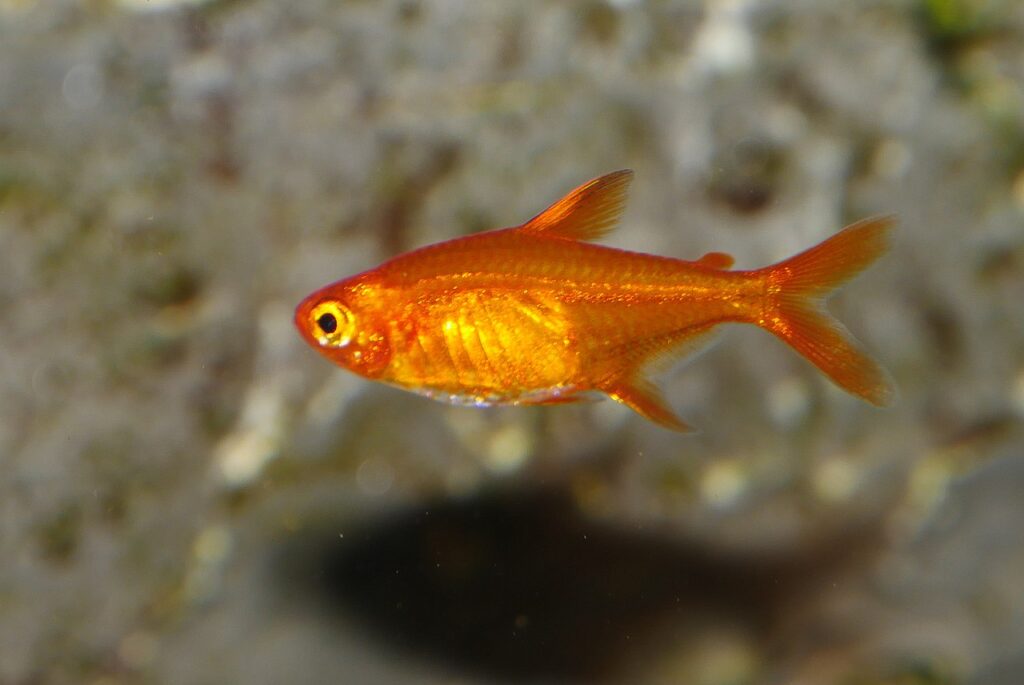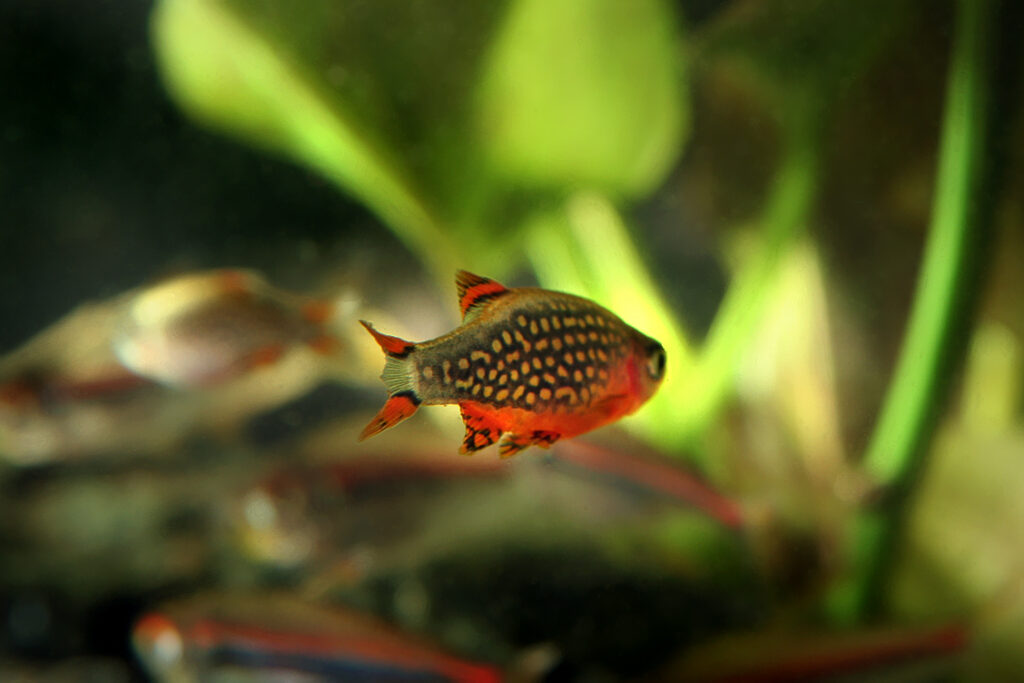This tiny, see-through animal lives at the bottom and loves to eat plant matter and leftover food. They are calm and get along with many other fish. These animals like to hide in plants or dig in the sand.
Table of Contents
This animal’s name comes from both Greek and Latin. Palaemon is the name of an old sea god, and paludosus means “marshy” or “swampy.” This is a perfect fit for their natural environment!
In the wild, these little guys live in North American fresh and salt water. That’s why they like streams, ponds, and marshes that move slowly. Their clear bodies help them hide from animals that are hungry.
There are many other freshwater and marine shrimp species in the Palaemonidae family, which this shrimp is in. They have a connection to crayfish and lobsters too!
Scientists think these shrimp are very cool. They look into how they thrive in different types of water and what part they play in the food chain. The fact that they eat small pieces of trash is also something that researchers are looking into.
A pet store or fish market might call them by a different name. They are sometimes called “Glass Shrimp” or “Grass Shrimp” because of the way they look and where they live.
For fun, these shrimp can grow back legs that they’ve lost. If something grabs them, they can lose a leg to get away, and later they will grow a new one.
These little cleaners get about 1 to 2 inches long. They live for about a year and, if things are right, can have babies every two weeks.
In the early 1900s, people began keeping them in aquariums. Since then, many people have added them to their home fish tanks to help them out.

Ghost Shrimp Key Information
These fascinating creatures are known for their nearly transparent bodies, which can make them appear almost invisible in the water. Their clear appearance is punctuated by small, scattered red or brown spots and occasionally a greenish tinge. This unique coloration serves as excellent camouflage in their natural habitats, allowing them to blend seamlessly with their surroundings.
Here’s a comprehensive table detailing various aspects of Ghost Shrimp:
| Family | Palaemonidae |
| Origin | North America |
| Price | Inexpensive, often sold as feeder shrimp |
| Common Names | Glass Shrimp, Grass Shrimp |
| Variants | None widely recognized |
| Ideal Tank Size | 5-10 gallons for a small group |
| Water Parameters | 65-82°F, pH 7.0-8.0, moderate hardness |
| Lifespan | 1-1.5 years |
| Full Size | 1-2 inches |
| Natural Environment | Freshwater streams, ponds, marshes |
| Behavior | Peaceful, active scavengers |
| Habitat Preference | Bottom-dweller, enjoys planted areas and hiding spots |
| Aquarium Decoration | Live plants, driftwood, rocks with crevices |
| Ideal Tank Mates | Small, peaceful fish and other shrimp species |
| Fish to Avoid | Large or aggressive fish that may eat them |
| Best Foods/Diet | Omnivorous: algae, detritus, commercial shrimp foods |
| Disease | Generally hardy, but susceptible to poor water quality |
| Sex-switch | No known sex-switching ability |
| Gender Differences | Females slightly larger with visible egg sacs when breeding |
| Care Level | Easy, suitable for beginners |
| Breeding Level | Easy in proper conditions |
Ideal Tank Mates for Ghost Shrimp
When choosing tank mates for Ghost Shrimp, it’s crucial to select peaceful species that won’t view these small crustaceans as prey. Ideal companions are calm, non-aggressive fish that occupy different areas of the tank. This allows the Ghost Shrimp to comfortably scavenge on the bottom without feeling threatened. Fish with similar water parameter requirements make excellent tank mates, ensuring a stable and harmonious aquatic environment.
Here’s a list of 10 ideal tank mates for Ghost Shrimp, each with their unique characteristics and compatibility reasons:
Neon Tetra

Neon Tetras are perfect companions for Ghost Shrimp due to their peaceful nature and small size. These vibrant fish add a splash of color to the aquarium while occupying the middle to upper water levels, leaving plenty of space for the shrimp to forage below. Their gentle demeanor means they won’t bother the Ghost Shrimp, creating a harmonious community tank.
| Common/Market Names | Neon Tetra, Cardinal Tetra, Blue Neon |
| Price Range | $2-$5 |
| Care Level | Easy |
| Behavior | Peaceful, Schooling |
| Life Span | 5-8 years |
| Max Size | 1.5 inches |
Corydoras Catfish

Corydoras Catfish make excellent tank mates for Ghost Shrimp as they share similar bottom-dwelling habits. These armored catfish are peaceful scavengers that won’t compete aggressively for food. Their presence can actually benefit the shrimp by stirring up detritus, making it easier for the Ghost Shrimp to find food particles.
| Common/Market Names | Cory Catfish, Corydoras |
| Price Range | $5-$15 |
| Care Level | Easy |
| Behavior | Peaceful, Social |
| Life Span | 3-5 years |
| Max Size | 2-3 inches |
Ember Tetra

Ember Tetras are tiny, flame-colored fish that work well with Ghost Shrimp. Their small size means they won’t intimidate the shrimp, and their preference for the upper water column ensures minimal interaction. These active little fish add life and movement to the tank without disturbing the shrimp’s territory.
| Common/Market Names | Ember Tetra, Fire Tetra |
| Price Range | $3-$6 |
| Care Level | Easy |
| Behavior | Peaceful, Schooling |
| Life Span | 2-4 years |
| Max Size | 0.8 inches |
Otocinclus Catfish

Otocinclus Catfish are peaceful algae eaters that make great companions for Ghost Shrimp. They occupy a similar niche but focus more on algae than detritus, reducing competition. Their small size and calm nature mean they won’t harm or stress the shrimp, making them ideal community members.
| Common/Market Names | Oto Catfish, Dwarf Sucker |
| Price Range | $3-$7 |
| Care Level | Moderate |
| Behavior | Peaceful, Schooling |
| Life Span | 3-5 years |
| Max Size | 2 inches |
Harlequin Rasbora

Harlequin Rasboras are elegant, copper-colored fish that complement Ghost Shrimp well. They prefer the middle to upper water levels, leaving the bottom free for the shrimp. Their peaceful temperament and small size ensure they won’t pose a threat to the Ghost Shrimp, creating a balanced community.
| Common/Market Names | Harlequin Rasbora, Red Rasbora |
| Price Range | $2-$5 |
| Care Level | Easy |
| Behavior | Peaceful, Schooling |
| Life Span | 5-8 years |
| Max Size | 2 inches |
Pygmy Corydoras

Pygmy Corydoras are tiny catfish that make delightful tank mates for Ghost Shrimp. Despite sharing the bottom of the tank, their miniature size means they won’t outcompete the shrimp for food or space. These social fish add interest to the lower levels without causing stress to the shrimp.
| Common/Market Names | Pygmy Cory, Dwarf Corydoras |
| Price Range | $3-$7 |
| Care Level | Easy to Moderate |
| Behavior | Peaceful, Schooling |
| Life Span | 3-5 years |
| Max Size | 1 inch |
Celestial Pearl Danio

Celestial Pearl Danios, with their starry patterns, are compatible with Ghost Shrimp due to their peaceful nature and small size. They prefer the middle water column, reducing interaction with the bottom-dwelling shrimp. Their shy behavior means they’re unlikely to bother the Ghost Shrimp, creating a serene community.
| Common/Market Names | Galaxy Rasbora, CPD |
| Price Range | $5-$10 |
| Care Level | Moderate |
| Behavior | Peaceful, Shy |
| Life Span | 3-5 years |
| Max Size | 1 inch |
Endler’s Livebearer

Endler’s Livebearers are colorful, active fish that work well with Ghost Shrimp. They occupy the upper parts of the tank, leaving the bottom free for the shrimp. Their small size and non-aggressive nature mean they won’t harass or eat the Ghost Shrimp, making them excellent community members.
| Common/Market Names | Endler Guppy |
| Price Range | $3-$8 |
| Care Level | Easy |
| Behavior | Peaceful, Active |
| Life Span | 2-3 years |
| Max Size | 1 inch |
Kuhli Loach

Kuhli Loaches are interesting, eel-like fish that can coexist peacefully with Ghost Shrimp. While they do share the bottom of the tank, Kuhli Loaches are nocturnal and spend much of their time hiding, reducing competition with the shrimp. Their peaceful nature ensures they won’t harm the Ghost Shrimp.
| Common/Market Names | Coolie Loach, Leopard Loach |
| Price Range | $3-$8 |
| Care Level | Easy to Moderate |
| Behavior | Peaceful, Shy |
| Life Span | 10+ years |
| Max Size | 4 inches |
Chili Rasbora

Chili Rasboras, with their bright red coloration, make charming tank mates for Ghost Shrimp. These tiny fish prefer the upper water levels, minimizing interaction with the bottom-dwelling shrimp. Their diminutive size and gentle nature ensure they pose no threat to the Ghost Shrimp, contributing to a peaceful and visually appealing aquarium.
| Common/Market Names | Mosquito Rasbora, Phoenix Rasbora |
| Price Range | $3-$7 |
| Care Level | Moderate |
| Behavior | Peaceful, Schooling |
| Life Span | 4-8 years |
| Max Size | 0.7 inches |
FAQs about Ghost Shrimp
Here are some FAQs about Ghost Shrimp that cover new topics:
How often should I feed Ghost Shrimp?
Feed Ghost Shrimp small amounts 2-3 times a week. They’re great scavengers and will find food in the tank between feedings.
Can Ghost Shrimp live in a bowl?
While they’re small, Ghost Shrimp need filtered water and space to thrive. A proper tank with filtration is best for their health.
Do Ghost Shrimp need a heater?
It depends on your room temperature. They prefer 65-82°F, so a small heater might be needed if your room is cool.
How many Ghost Shrimp can I keep together?
You can keep about 2-3 Ghost Shrimp per gallon of water. They’re social and do well in groups.
Will Ghost Shrimp eat live plants?
Ghost Shrimp mainly eat algae and leftover food. They might nibble on very soft plants but generally don’t harm aquarium plants.
How can I tell if my Ghost Shrimp are stressed?
Stressed Ghost Shrimp may become less active, hide more, or develop a cloudy appearance. Poor water quality is often the cause.
Do Ghost Shrimp need special food?
While they’ll eat most leftovers, offering algae wafers or shrimp-specific food once a week ensures they get proper nutrition.
Can Ghost Shrimp live with bettas?
It depends on the betta’s temperament. Some bettas may see Ghost Shrimp as food, while others coexist peacefully.
How do I know if my Ghost Shrimp are breeding?
Female Ghost Shrimp carry eggs under their tails. The eggs look like small green or yellow dots.
Do Ghost Shrimp need hiding places?
Yes, Ghost Shrimp appreciate hiding spots. Plants, caves, or small tubes provide security, especially during molting.

Leave a Reply